

McKnight Foundation
HISTORY

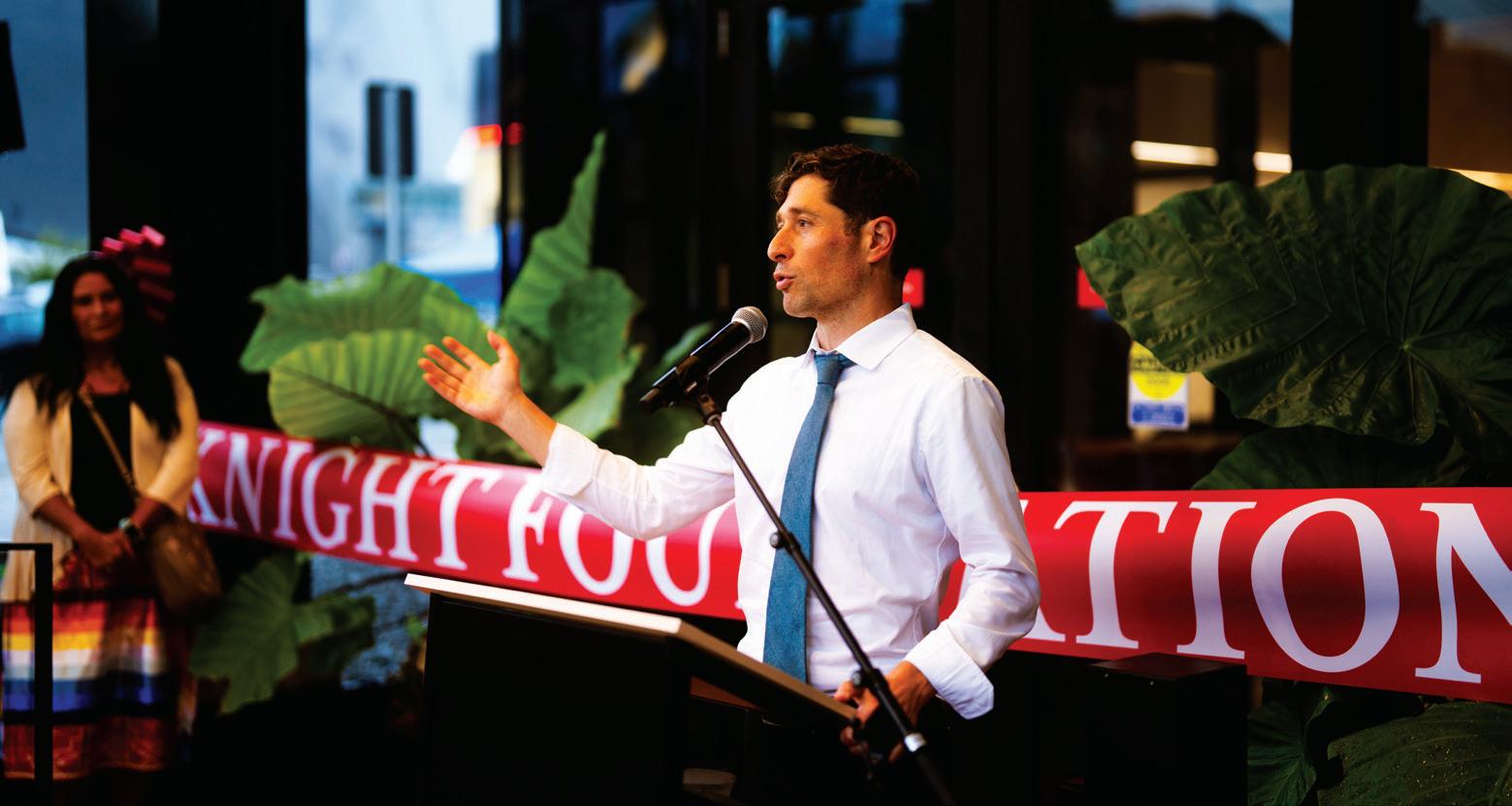
(L-R) Peg Birk, Phyllis Goff, Perry Moriearty, James (Mac) Binger, Erika Binger and Tonya Allen officially open the new office.
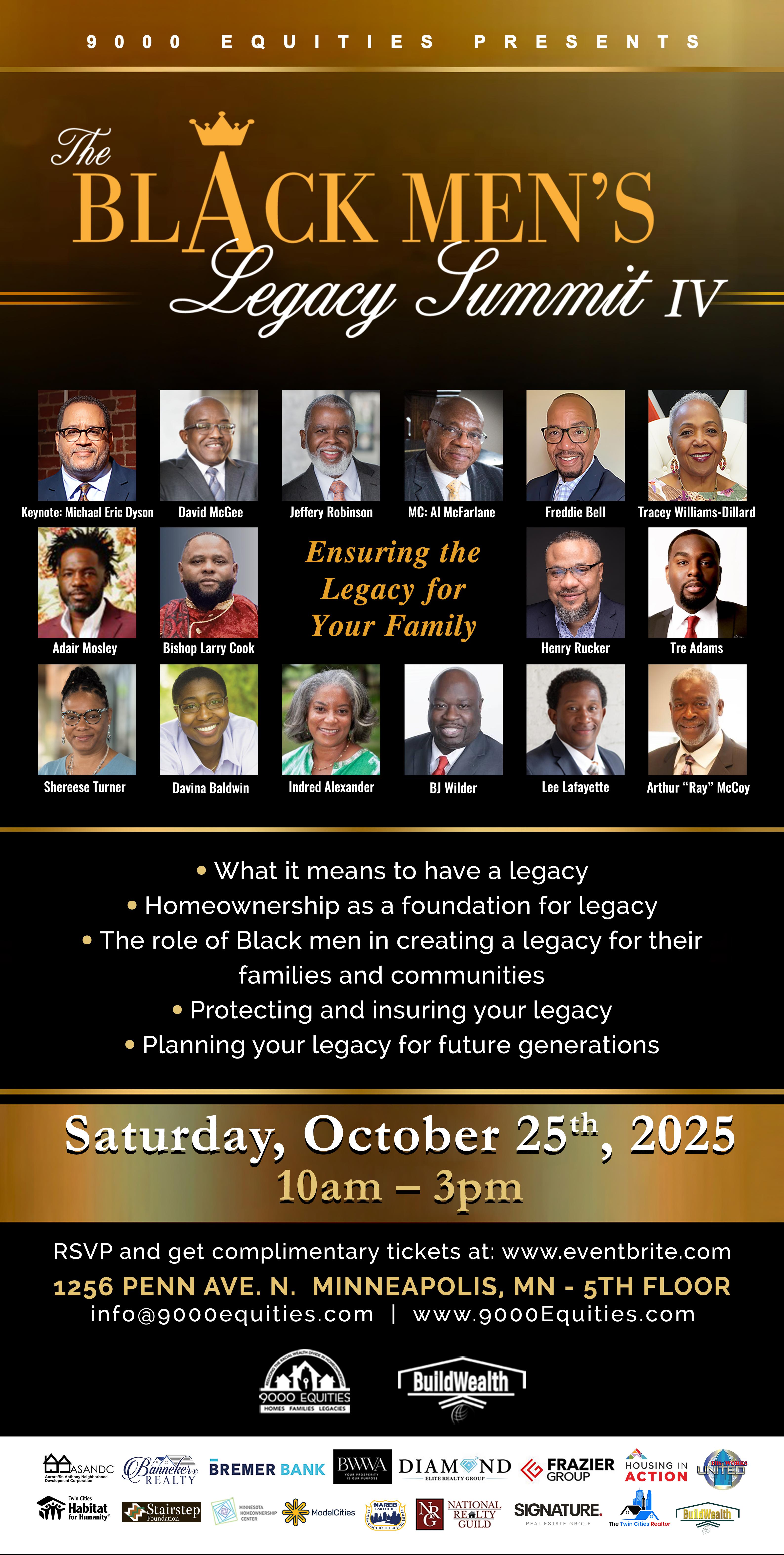


Tonya Allen: Showing what is possible when sustainability meets innovation
make the world more sustainable.


“As we have been for nearly 75 years, McKnight is proud to stay rooted in our community with a new office that is a physical manifestation of our mission to benefit people and our planet,” said McKnight Foundation board chair Ted Staryk. “By investing in a historic building near the heart of downtown Minneapolis, we are both honoring our past and setting the stage for a promising future with the community we serve.”
In lieu of pursuing new construction, the Foundation chose to renovate and reinvigorate a historic building—the office comprises four connected structures, the oldest of which were erected in 1883 and 1890, that housed businesses serving the growing city’s
milling district. This approach allowed McKnight to advance its environmental goals in the remodel and invest in a culturally significant corridor in the city’s Downtown East neighborhood, demonstrating how tenants can lead on sustainability and community impact. McKnight has previously invested in historic spaces with its 2003 move into the Washburn A Mill complex as an anchor tenant above the Mill City Museum.


“For nearly 75 years, this foundation, a family foundation, has believed that people
“This is more than just an office—it’s a hub for changemakers,” said Tonya Allen, president of McKnight Foundation. “We designed a space where people from all backgrounds can come together to collaborate and get big things done to improve lives in our community and around the world. We’re showing how building owners and tenants alike can express their values and live out their missions through the built environment.”
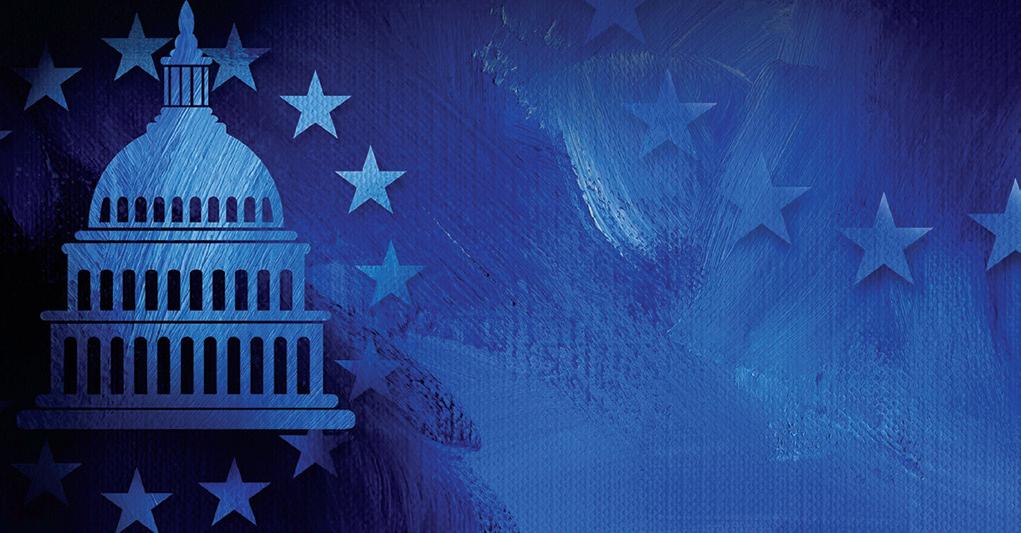

Moriearty, Shelly
Phyllis Goff, Erika Binger, Tonya Allen, James (Mac) Binger, Mayor Jacob Frey
Graphic illustration of iconic American Capitol dome and simple ring of stars on abstract oil paint background
Credit: Wikipedia Minneapolis Police Chief Brian O’Hara
KMOJ
By Stacy M. Brown Black Press USA Senior National Correspondent

By Haley Taylor Schlitz, Esq.
There is a moment at the end of Spike Lee’s School Daze that refuses to fade, no matter how many years pass. The screen fills with the early morning light on a college campus, and a young activist named Dap bolts across the yard, his voice carrying a desperate command: “Wake up!” The scene is surreal, almost dreamlike, yet piercing in its clarity. Though the film came out in 1988, its closing scene carries a prophetic resonance that speaks just as forcefully today. It was a warning that the real struggle over education was not about grades or degrees, but about power, access, and the right to a future. That same command echoes now. President Trump’s new policy imposing a onetime $100,000 fee on H-1B visa applications is more than an immigration change. It is another alarm. At first, the ad-
ministration frames it as a way to protect American workers. Yet when we place this move alongside the broader attacks on higher education, the pattern becomes impossible to ignore. Federal agencies have stripped away research funding. Diversity, equity, and inclusion programs have been dismantled. Seen together, these choices form a strategy. They are not accidents. They are deliberate. Some will say this is a mixed message. We are told young people do not need college, while high-paying careers in technology, medicine, and engineering require advanced education. We are told American companies should hire domestically, while the very pipeline that educates and trains the next generation is being narrowed. Mixed message? No. There is no contradiction here. The pattern is intentional. For my generation, Gen Z, and for the generation that follows, Gen Alpha, the message is sharp. We are the most diverse generations in American history, and the policies being written today are defining the limits of our tomorrow. Do not expect college to be a reliable path of opportunity.

Do not expect the jobs of the future to welcome you either. The gates are being fortified while the ladders are being pulled away.
The consequences are not hidden. In Minnesota, companies such as Mayo Clinic, UnitedHealth Group, Target, and 3M depend on highly skilled workers. The H-1B visa program has helped them fill critical roles in health care, technology, and research. Nationally, the very leaders who shape the industries of tomorrow acknowledge how dependent they
are on foreign talent. NVIDIA’s Jensen Huang said, “We want all the brightest minds to come to the U.S. and remember immigration is the foundation of the American Dream.” OpenAI’s Sam Altman added, “We need to get the smartest people in the country, and streamlining that process and also outlining financial incentives seems good to me.”
But what is missing from those statements is just as revealing as what is included. When CEOs accept the premise that the solution to their talent
needs lies only in immigration, they reinforce the dangerous idea that America’s own rising generations cannot meet the challenge. As our universities lose funding, as DEI programs are dismantled, as opportunities for students of color shrink, Gen Z and Gen Alpha are left to wonder why they are not seen as the “smartest people” who can power the future. That silence is a slap in the face. It accepts the erosion of our education system as inevitable and overlooks the potential of millions of young people growing up here, ready
to learn, ready to innovate, and ready to lead.
This is why I return to School Daze. The cry to “wake up” is not simply about a movie my parents made me watch when I began college. It is about seeing clearly in moments like this, when policies are presented as reforms but are, in truth, barriers. It is about understanding that what is under attack is not just an immigration program or a college grant. What is under attack is the very idea that education and innovation should be accessible to all who are willing to work for them.
For Black communities, for immigrant families, and for the young people who are being told that their dreams are unrealistic, the wake-up call is urgent. We cannot afford to see these battles as isolated. They are linked. They are coordinated. They are designed to decide who gets educated, who gets employed, and ultimately, who gets to lead in the decades ahead.
In 1988, Dap’s cry rang out across a fictional campus. In 2025, the call rings out across an entire nation. We must wake up. Not later. Now.
Members of the Congressional Black Caucus were split on the question of whether Charlie Kirk, a rightwing commentator with controversial views on race, should be honored by a lengthy Republican-penned resolution in his honor. The final vote tells part of the story. All Republicans who voted, 215, voted in favor of the Kirk Resolution (with four missing the vote), along with 95 Democrats. Fifty-eight Democrats voted against the Kirk Resolution, and 38 members, all Democrats, voted “present.” The most interesting tally of the vote on the Kirk Resolution was the number of members of the U.S. House who “missed” the vote: 26. Members of the Congres-

sional Black Caucus who voted in favor of honoring Charlie Kirk were Democratic Leader Hakeem Jeffries (D-BY),
Reps. Don Davis (D-NC), Greg Meeks (D-NY), and David Scott (D-NY). Two members of the CBC didn’t vote: Reps. Marc Veasey (D-TX) and Joe Neguse (D-CO). All other Black Caucus members voted “NO” on the Kirk resolution or “present.” Leadership pressured several members of Congress to “take a walk” rather than vote NO to honoring Kirk. All three members of the Democratic leadership, Leader Jeffries, Democratic Whip Rep. Katherine Clark, and Democratic Caucus Chairman Rep. Pete Aguilar, voted YES on the Kirk Resolution. Despite Kirk’s murder at 31, which was captured on a shocking video widely shared on social media, many elected officials and political observers have noted Kirk’s many controversial statements over the years. Kirk was shot as he spoke on the first stop of a col-
lege tour at Orem, Utah Valley University. Kirk’s violent public murder has prompted Republicans to leverage his death into a way to punish anyone critical of Kirk or who spoke out about the irony of his death, given his pro-second amendment public statements. A website has been set up by his supporters listing anyone who has made any statement of controversy that Kirk supporters deem problematic. The Republican-written Kirk Resolution included statements against political violence. “How you die does not redeem how you lived. I do not celebrate anyone’s murder. Charlie Kirk did not deserve to be murdered. But I’m overwhelmed to see the nation’s flag fly and half-staff for a man who was a proud racist who spent his entire life sowing seeds of division and hatred into this land,” said Pastor Dr. Howard-John
Wesley during his Sunday sermon at Alfred Street baptist Church on Sept. 14. Wesley’s sermon has gone viral on social media with millions of views.
“We must condemn violence without abandoning our right to speak out against ideas that are inconsistent with our values as Americans. We strongly disagree with many of the beliefs Charlie Kirk promoted: including his belief that the Civil Rights Act of 1964, which ended racial segregation, was a mistake; his denial that systemic racism exists; his promotion of the Great Replacement theory; and his offensive claims about Justice Ketanji Brown Jackson, Michelle Obama, and Congresswoman Sheila Jackson Lee lacking adequate cognitive ability,” wrote the Congressional Black Caucus in their official statement released after the vote on Sept. 19.
Kirk made negative statements about Ivy League graduates U.S. Supreme Court
Associate Justice Jackson, journalist Joy Reid, the late Congressman Sheila Jackson Lee, and former First Lady Michelle Obama, implying that all of the Harvard Law, Harvard College, and Princeton graduates were successful because of affirmative action. In relation to the criticism of the accomplished Black women, Kirk said on his show in July 2023 that, “Black women do not have brain processing power to be taken seriously. You have to go steal a white person’s slot.” “The resolution introduced in the House to honor Charlie Kirk’s legacy is not about healing, lowering the temperature of our political discourse, or even ensuring the safety of members of Congress, staff, and Capitol personnel. It is, unfortunately, an attempt to legitimize Kirk’s worldview — a worldview that includes ideas many Americans find racist, harmful, and fundamentally un-American,” the Congressional Black Caucus statement further stated. In a moment when Republicans remain against any prohibitions on assault weapons or any other firearms. One of Kirk’s most notable phrases has been posted by many on social media. “Having an armed citizenry comes with a price, and that is part of liberty… We need to be very clear that you’re not going to get gun deaths to zero. It will not happen. But I think it’s worth it. I think it’s worth it to have a cost of, unfortunately, some gun deaths every single year, so that we can have the Second Amendment,” Kirk once said.






Lawmakers in handcuffs after protesting ICE detention in Manhattan
By Stacy M. Brown Black Press USA Senior National Correspondent
At 26 Federal Plaza in Manhattan, where despair clings to the walls, federal officers placed handcuffs on the very people chosen to protect justice.
Comptroller Brad Lander, state senators Julia Salazar, Jabari Brisport, and Gustavo Rivera, along with assembly members Emily Gallagher, Robert Carroll, Marcela Mitaynes, Jessica González-Rojas, Claire Valdez,

Tony Simone, and Steven Raga were taken into custody. Public Advocate Jumaane Williams and council members Tiffany Cabán and Sandy Nurse were arrested outside the federal building as they stood with protesters against Immigration and Customs Enforcement. Their offense was not theft or violence. Their offense was demanding to witness what a federal judge had already condemned as unlawful. Inside the building migrants were forced into cells no larger than a kitchen, as many as ninety people crowded together with no bed-
ding, no soap, no medicine, and no privacy when using the toilet. When federal agents denied entry, the lawmakers sat on the floor. They chanted. They raised a banner that read “New Yorkers against ICE.” The response came in zip ties and duct tape sealing cracks in the door so nothing could be seen. Officials had been warned they could stay in the elevator bay but would be arrested if they refused to move. They refused.
Outside, more than seventy New Yorkers lifted their voices, blocking the garage doors as ICE vans prepared to move detainees. “Say it loud, say it clear, immigrants are welcome here,” they chanted until police dragged them away. Emily Gallagher spoke plainly about the meaning of the arrests.
“The criminalization, demonization, and state-sponsored violence against immigrants in this country has reached a fever pitch under this administration. All of us, and especially elected leaders, must do more to protect New Yorkers, regardless of when they arrived,” she said.
Right-wing extremist violence is more frequent and more deadly than left-wing violence - what the data shows
By Art Jipson
After the Sept. 10, 2025, assassination of conservative political activist Charlie Kirk, President Donald Trump claimed that radical leftist groups foment political violence in the U.S., and “they should be put in jail.”
“The radical left causes tremendous violence,” he said, asserting that “they seem to do it in a bigger way” than groups on the right.
Top presidential adviser Stephen Miller also weighed in after Kirk’s killing, saying that left-wing political organizations constitute “a vast domestic terror movement.”
“We are going to use every resource we have … throughout this government to identify, disrupt, dismantle and destroy these networks and make America safe again,” Miller said.
But policymakers and the public need reliable evidence and actual data to understand the reality of politically motivated violence. From our research on extremism, it’s clear that the president’s and Miller’s assertions about political violence from the left are not based on actual facts.
Based on our own research and a review of related work, we can confidently say that most domestic terrorists in the U.S. are politically on the right, and right-wing attacks account for the vast majority of fatalities from domestic terrorism.
Political violence rising
The understanding of political violence is complicated by differences in definitions and the recent Department of Justice removal of an important government-sponsored study of domestic terrorists.
Political violence in the U.S. has risen in recent months and takes forms that go
unrecognized. During the 2024 election cycle, nearly half of all states reported threats against election workers, including social media death threats, intimidation and doxing.
Kirk’s assassination illustrates the growing threat.
The man charged with the murder, Tyler Robinson, allegedly planned the attack in writing and online.
This follows other politically motivated killings, including the June assassination of Democratic Minnesota state Rep. and former House Speaker Melissa Hortman and her husband.
These incidents reflect a normalization of political violence. Threats and violence are increasingly treated as acceptable for achieving political goals, posing serious risks to democracy and society.
Defining ‘political violence’
This article relies on some of our research on extremism, other academic research, federal reports, academic datasets and other monitoring to assess what is known about political violence.
Support for political violence in the U.S. is spreading from extremist fringes into the mainstream, making violent actions seem normal. Threats can move from online rhetoric to actual violence, posing serious risks to democratic practices.
But different agencies and researchers use different definitions of political violence, making comparisons difficult.
The FBI and Department of Homeland Security define domestic violent extremism as threats involving actual violence. They do not investigate people in the U.S. for constitutionally protected speech, activism or ideological beliefs. Domestic violent extremism is defined by the FBI and Department of Homeland Security as violence or credible threats of violence intended to influence government policy or intimidate civilians for political or ideological purposes. This general framing, which includes diverse activities under a single category, guides investigations and prosecutions.
Datasets compiled
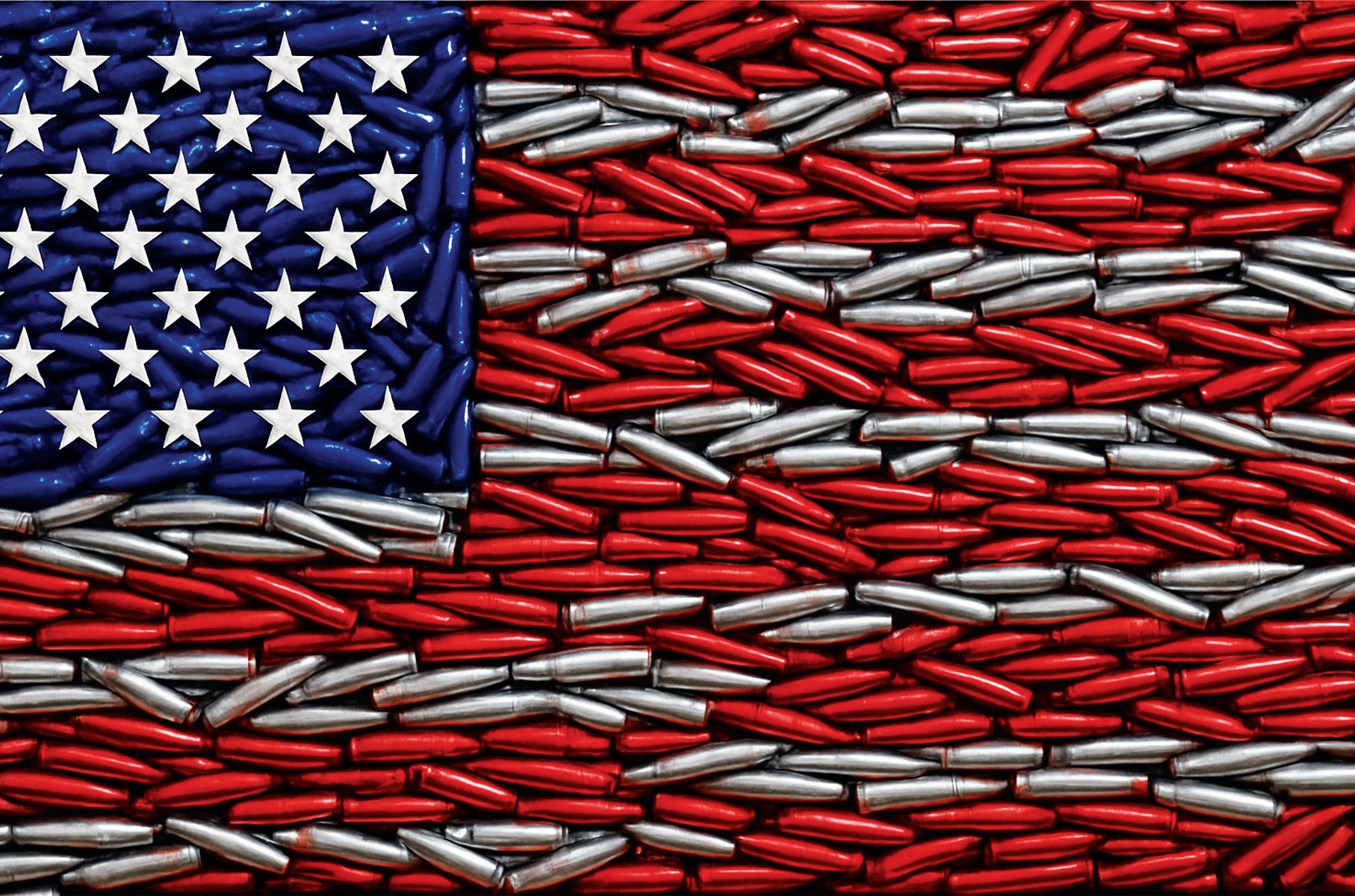
by academic researchers use narrower and more operational definitions. The Global Terrorism Database counts incidents that involve intentional violence with political, social or religious motivation.
These differences mean that the same incident may or may not appear in a dataset, depending on the rules applied.
The FBI and Department of Homeland Security emphasize that these distinctions are not merely academic. Labeling an event “terrorism” rather than a “hate crime” can change who is responsible for investigating an incident and how many resources they have to investigate it.
For example, a politically motivated shooting might be coded as terrorism in federal reporting, cataloged as political violence by the Armed Conflict Location and Event Data Project, and prosecuted as homicide or a hate crime at the state level. Patterns in incidents and fatalities
Despite differences in definitions, several consistent patterns emerge from available evidence.
Politically motivated violence is a small fraction of total violent crime, but its impact is magnified by symbolic targets, timing and media coverage.
In the first half of 2025, 35% of violent events tracked by University of Maryland researchers targeted U.S. government personnel or facilities – more than twice the rate in 2024.
Right-wing extremist violence has been deadlier than left-wing violence in recent years.
Based on government and independent analyses, rightwing extremist violence has been responsible for the overwhelming majority of fatalities, amounting to approximately 75% to 80% of U.S. domestic terrorism deaths since 2001. Illustrative cases include the 2015 Charleston church shooting, when white supremacist Dylann Roof killed nine Black parishioners; the 2018 Tree of Life synagogue attack in Pittsburgh, where 11 worshippers were murdered; the 2019 El Paso Walmart massacre, in which an anti-immigrant gunman killed 23 people. The 1995 Oklahoma City bombing, an earlier but still notable example, killed 168 in the deadliest domestic terrorist attack in U.S. history.
By contrast, left-wing extremist incidents, including those tied to anarchist or environmental movements, have made up about 10% to 15% of incidents and less than 5% of fatalities.
Examples include the Animal Liberation Front and Earth Liberation Front arson and vandalism campaigns in the 1990s and 2000s, which were more likely to target property rather than people.
Violence occurred during Seattle May Day protests in 2016, with anarchist groups and other demonstrators clashing with police. The clashes resulted in multiple injuries and arrests. In 2016, five Dallas police officers were murdered by a heavily armed sniper who was targeting white police officers.
Hard to count
There’s another reason it’s hard to account for and characterize certain kinds of political violence and those who perpetrate it.
The U.S. focuses on prosecuting criminal acts rather than formally designating organizations as terrorist, relying on existing statutes such as conspiracy, weapons violations, RICO provisions and hate crime laws to pursue individuals for specific acts of violence.
Unlike foreign terrorism, the federal government does not have a mechanism to formally charge an individual with domestic terrorism. That makes it difficult to characterize someone as a domestic terrorist.
The State Department’s Foreign Terrorist Organization list applies only to
groups outside of the United States. By contrast, U.S. law bars the government from labeling domestic political organizations as terrorist entities because of First Amendment free speech protections.
Rhetoric is not evidence
Without harmonized reporting and uniform definitions, the data will not provide an accurate overview of political violence in the U.S.
But we can make some important conclusions.
Politically motivated violence in the U.S. is rare compared with overall violent crime. Political violence has a disproportionate impact because even rare incidents can amplify fear, influence policy and deepen societal polarization.
Right-wing extremist violence has been more frequent and more lethal than leftwing violence. The number of extremist groups is substantial and skewed toward the right, although a count of organizations does not necessarily reflect incidents of violence.
High-profile political violence often brings heightened rhetoric and pressure for sweeping responses. Yet the empirical record shows that political violence remains concentrated within specific movements and networks rather than spread evenly across the ideological spectrum. Distinguishing between rhetoric and evidence is essential for democracy.
Trump and members of his administration are threatening to target whole organizations and movements and the people who work in them with aggressive legal measures – to jail them or scrutinize their favorable tax status. But research shows that the majority of political violence comes from people following right-wing ideologies.
Disclosure statement
The authors do not work for, consult, own shares in or receive funding from any company or organisation that would benefit from this article, and have disclosed no relevant affiliations beyond their academic appointment.
Resolution honoring Charlie Kirk becomes critical test for the Black Caucus
“This is the worst I’ve felt about this country in years,” said Rep. Emanuel Cleaver, standing on the House steps and talking about the state of play in the U.S. “I can’t imagine anyone voting against this resolution,” said House Speaker Mike Johnson (R-La.) as members of the House, led by Republicans Andy Biggs and Paul Gosar, considered a resolution to honor Charlie Kirk. Kirk was murdered on September 10 during an outdoor appearance at Utah Valley University.
After much backroom maneuvering, the final vote on the resolution honoring Kirk was moved from Thursday to Friday, Sept. 18. For members of the Congressional Black Caucus, the vote is in no way a casual action on a boilerplate resolution. Charlie Kirk was known for critical comments on Black people and communities and targeted several Black women
with negative comments, implying that they were successful only because of affirmative action. After a lengthy Democratic Caucus on the morning of September 18, Minority Leader Hakeem Jeffries listened to the concerns of members of his caucus. After the meeting, Black Press USA asked Leader Jeffries if he was whipping the vote and what he would vote. The Leader from Brooklyn gave no direct answers. “Members will vote their conscious. We will issue a statement shortly,” Leader Jeffries said flatly.
Texas Congressman Marc Veasey (D-TX) is countering Republicans with a more straightforward resolution worded to denounce political violence in the wake of Kirk’s murder. But regarding the GOP’s Kirk resolution, several CBC members said they planned to vote “present.” Others are a solid NO. Some members in tight political districts are referencing their constituents but not giving clear answers on how they will vote. Typical-
ly, congressional resolutions are not controversial, but the Kirk resolution is all but certain to be in lieu of Kirk’s racist and misogynistic statements. The vote will be a test of where members draw the line on a continuous push by MAGA Republicans to engage in culture war politics.
“I can’t stand the word empathy, actually,” Kirk once said.
“I think empathy is a made-up, new age term that does a lot of damage,” he added.
“If I see a Black pilot, I’m gonna be like boy, I hope he’s qualified,” Kirk said on his show. But the issue of whether Black Democrats will separate the man from his statements and the violent way he died at only 31 while speaking at a college event with Kirk’s bigoted views will require messaging strategies Democrats often fail at — assuming they have a messaging strategy at all. “Black women do not have the brain processing power to be taken seriously. You have to go steal a white person’s slot,” Kirk said on his show in July 2023 as he attacked jour

nalist Joy Reid, former First Lady Michelle Obama, that late Rep. Sheila Jackson Lee, and Supreme Court Associate Justice Ketanji Brown Jackson — all Ivy League graduates.
Associate Professor of Sociology, University of Dayton
Paul J. Becker
Associate Professor of Sociology, University of Dayton
Credit: Douglass Rissing
The House of Representatives
By Lauren Burke Black Press USA
Shooting
Hennepin Healthcare Hospital are expected to survive their injuries.
along Lake Street, approximately one or two blocks away. The five men and one woman who were injured by gunfire were transported by ambulance to
From 3
contempt for their own base. The numbers tell the story. House Democrats proudly announced a $3 million ad blitz hitting Republicans over tariffs and the looming shutdown. The DNC spent big on a paid campaign blanketing Wisconsin newspapers to attack Elon Musk during a state Supreme Court election. They rolled out a five-figure ad buy targeting Tennessee Republicans with Epstein-related attacks. The DCCC unleashed a national ad campaign aimed at Latino, Black, and AANHPI voters, blaming Republicans for back-to-school prices, followed
From 3
From 3 strengthen a legacy that can serve the community and the region for generations to come.
The Site Reveal Celebration at the new construction
McKnight
From Page 3
and planet go hand in hand. And this building is proof that our value isn't just words. It is carved into every beam of this building. It's built into every system, and woven in every design choice, honoring the history of the McKnight Foundation. We're showing what is possible when sustainability meets innovation,” Allen said.
“We believe that history can be changed in these offices, and that's why we wanted to create this space for changemakers and to make a commitment to our community. Our legacy and roots are here in Minneapolis since 1953,” she said.
In its previous headquarters, McKnight annually welcomed more than 3,000 state, national, and global nonprofit partners and leaders. Just a five-minute walk from its former office, the larger space expands McKnight’s ability to host even more dedicated changemakers. In the four months since opening, Allen said, the Foundation has already welcomed 2,000 people working on a wide range of important issues: expanding support for local journalism and artists, creating wealth-building opportunities for residents and businesses, and growing green jobs and clean energy projects.
McKnight’s new headquarters, which is fully ADA compliant, showcases sustainable building approaches, aligning with their Midwest Climate & Energy program and grantee partners such as Sabathani Community Center, Historic Coliseum Building, and the Minneapolis American
Police said a man stepped out of a vehicle and fired an estimated 30 rounds from a high-velocity .223 rifle at a group gathered on the sidewalk along Clinton Ave before fleeing the scene in the vehicle. On September 22nd
by another round of ads—its first national digital buy of the 2026 cycle—hammering Republicans for jeopardizing rural hospitals. Millions for consultants, millions for TV, millions for newspaper spreads in majority-white outlets. But when it comes to the Black Press of America—a network of 200 Black-owned newspapers and media companies, many run by Black women—Democrats turn their pockets inside out. This is no small network. The Black Press has the potential to reach more than 30 million readers, viewers, and subscribers every week through its newspapers, websites, social platforms, and daily broadcasts. It has never asked for handouts, only a fair shake. Yet, despite all their boasts of diversity, Dem-

Indian Center that are creating vibrant community hubs while reducing pollution.
“The work of innovative building projects like McKnight Foundation is a fundamental driving force in transforming the way our buildings are built, designed and operated,” said Peter Templeton, president and CEO, USGBC. “Buildings that achieve LEED certification are lowering carbon emissions, reducing operating costs and conserving resources while prioritizing sustainable practices and human health. Because of the McKnight Foundation, we are increasing the number of green buildings and getting closer to USGBC’s goal to outpace conventional buildings, while being environmentally and socially responsible and improving quality of life for generations to come.”
Among the standout features are a fully electric heating and cooling system that eliminates fossil fuels and lowers energy demand—even through Minnesota’s extreme seasons—using thermal energy storage tanks that heat and cool the building using ice, complemented by heat pumps and solar heating.
A direct-pay $1.5 million federal tax credit through the Inflation Reduction Act helped finance the energy-efficient system—one of Minnesota’s first tenant-led clean energy deals. Using healthy, sustainable building materials and reclaimed elements resulted in diverting more than 75% of landfill construction waste and avoiding more than a ton of fossil-fuel-derived plastic from landfills.
Additional green and wellbeing features include low-carbon commuting options with easy transit access,
at approximately 10:45 p.m., Minneapolis Police Officers working near the 600 block of 1st Avenue N located Trayveion Green who had an arrest warrant for murder. They arrested him without incident and booked him into the Hennepin County Jail. He has been charged with seven counts of Murder - 2nd Degree - With Intent-Not Pre-
ocrats have invested nothing close to the millions they shovel elsewhere. And this betrayal comes at a historic moment: the Black Press is approaching its 200th anniversary in 2027. Founded in 1827 by John B. Russwurm and Samuel Cornish with the bold declaration, “We wish to plead our own cause. For too long others have spoken for us,” the Black Press has carried that mission through every trial of Black America. Yet today, as it struggles financially to reach that milestone, the very party that owes its survival to Black voters has turned its back. During the pandemic, Democrats flocked to the Black Press’ daily broadcast, Let It Be Known. They wanted to be platformed, wanted their voices carried into Black homes.
site, 2125 Lowry Avenue North, Minneapolis is Wednesday, October 15, 2025, at 11am. The new facility will allow for expanded community programming, extended training for youth and future broadcasters, and provide improved broadcast and digital capabili-
bike paths and parking, electric vehicle charging, prayer and wellness rooms, all-gender restrooms, and ample natural light. A new in-house creative studio enables staff and nonprofit partners to produce multimedia content to tell powerful stories.
A highly visible exterior mural wall, facing U.S. Bank Stadium, will provide a rotating canvas for Minnesota artists and culture bearers, connecting the building to McKnight’s Arts & Culture program, which has funded artists and the arts and cultural ecosystem of Minnesota for 50 years. The first artist or team of artists to be featured will be announced in Fall 2025.
Partnerships with a diverse team of local businesses helped realize the 50,000-square-foot transformation: 5 by 5 Design, Avisen Legal with Crowe, Dunham Associates, FORTÉ, Greiner Construction with Action Construction Services, Habitable, Hunt Electric, KimbleCo, Loucks, Modern Heating & Air, NAC Mechanical & Electrical Services and APi Group, Parameters, Ideal Workplace Solutions, Reigstad Engineers, Studio BV with Mobilize Design & Architecture, Trane, and others.
McKnight’s current and previous offices are located on the ancestral and present-day homelands of the Dakota people, including Owámniyomni, or St. Anthony Falls, a sacred place for Dakota. “With McKnight Foundation’s focus on advancing justice, climate solutions, and vibrant communities, we celebrate not only their new space in this neighborhood but the correlation between their work and our vision for reclaiming Owámniyomni as a place of healing, beauty and belong-

meditated. Trayveion Green is the third person to be charged in connection with this shooting.
Ryan Timothy Quinn and Tiffany Lynn Marie Martindale were arrested on August 26th and were charged with Aiding an Offender on Probation/Parole/ Sup Rel-A&D Order Issued (609.495.1(b)) on August 29th.
But once they were elected, the same voices that begged for space disappeared. What remains is foul lip service, the kind that sounds no different from Trump’s contempt for diversity. The insult is deeper when measured against history. Frederick Douglass thundered through The North Star. Ida B. Wells laid bare the horror of lynching through the Memphis Free Speech. The Chicago Defender carried the voices of the Great Migration and showed the mutilated body of Emmett Till. The Afro American chronicled Jackie Robinson and Martin Luther King Jr. When Tulsa burned, white mobs destroyed Black newspapers to smother the truth. When Dr. King wrote from Birmingham Jail, it was the Black
ties. The permanent home ensures that KMOJ will remain the heartbeat of the community, station management said. The event also marks the official launch of KMOJ’s $17 million capital campaign, which will fund the new broadcast center, set to be completed by 2028.
ing for everyone,” said Shelley Buck, President of Owámniyomni Okhódayapi. McKnight supported the organization in initiating the restoration of St. Anthony Falls as Owámniyomni. The organization is work-
“These arrests underscore the professionalism and relentless dedication of our highly skilled investigators,” said Chief O’Hara. “This mass shooting outside an occupied school had a chilling impact on our entire community, and I am deeply grateful to everyone who contributed to this investigation. The level of firepower unleashed in broad daylight on a city street is sickening and completely unacceptable,” said Chief O’Hara. "Our thoughts are for the victim who lost his life, with those who are now fighting to recover from their injuries, and with the families and community members who are forever impacted by this violence.
Press that carried his words. When the Wilmington Ten were caged, it was the Black Press that refused to look away. And today, the torch is still burning. April D. Ryan is today’s Alice Dunnigan. Lauren Burke is today’s Ethel Payne. Sam P.K. Collins is a modern-day Marcus Garvey. HBCU students have both interned and currently work full-time with the Black Press. The Black Press is not dead history—it is a living force.
So, let the question be asked plainly: if the RNC wrote checks tomorrow to the Black Press, would Democrats call us sellouts? Would they smear us while continuing to funnel millions into papers and platforms that do not speak to our communities?
“This is more than a building, it’s our forever home,” said Freddie Bell, KMOJ General Manager & CEO. “It is a permanent commitment to North Minneapolis, to our listeners, and to the future of community media. We want everyone to see where we are headed and cele-
ing in close coordination with Minnesota’s four Dakota Tribes to reclaim five acres of land at Owámniyomni and transform the site into a place of healing, connection, and education that honors Dakota history and liv-
The truth is this: Democrats have betrayed the very institution that has carried them time and again. They can spend $3 million to flood swing districts, or blanket Wisconsin papers with
ing culture. Learn more
ry, and more at
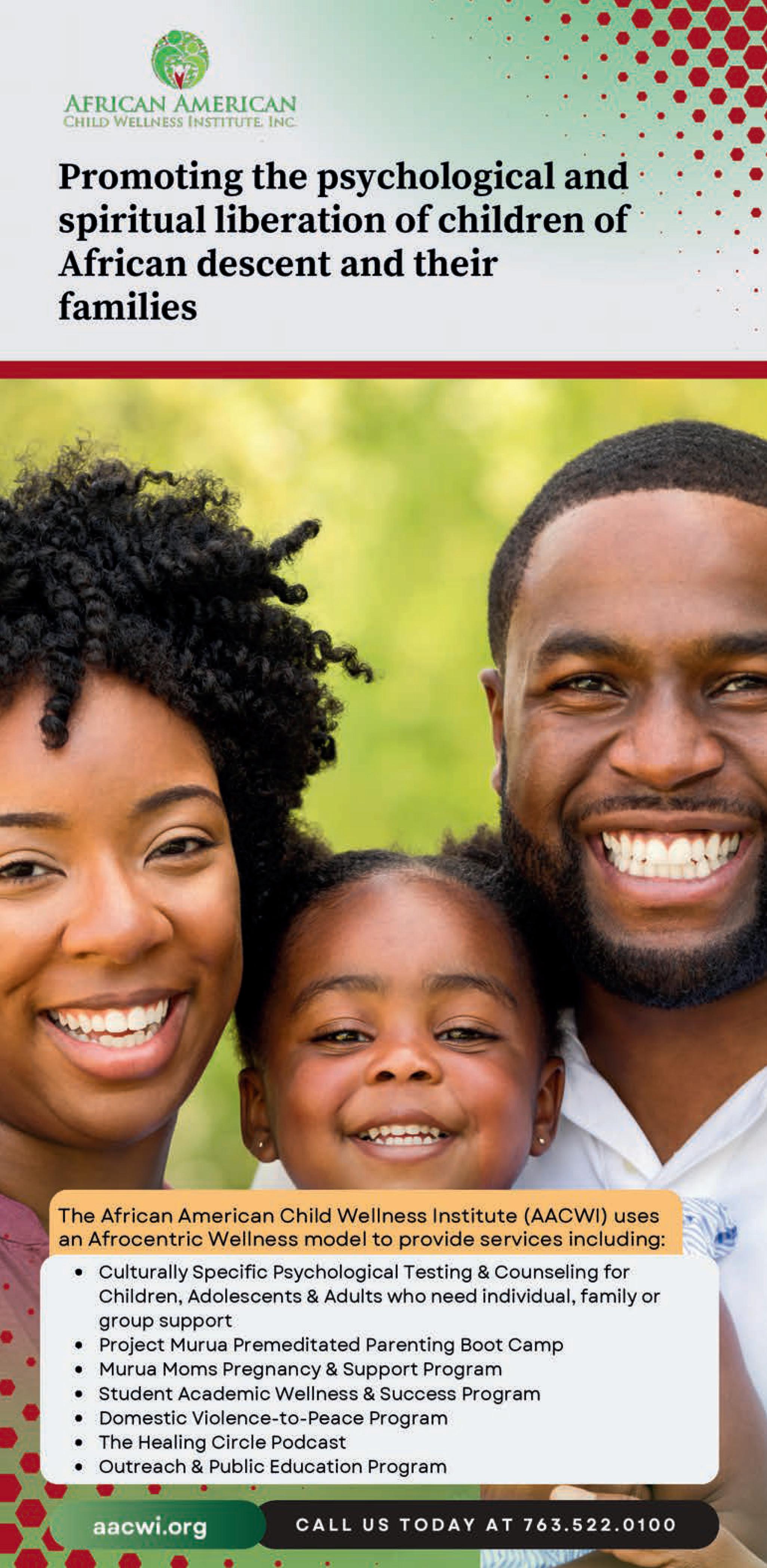
Credit: Raww Files Media
Alsa Bruno, Brass Solidarity, Lead Vocalist
By Jo Mackiewicz Professor of Rhetoric and Professional Communication, Iowa State University
A few years ago, while working as a professor and as a welder at a small repair and fabrication shop, I went looking for books about women in the skilled trades. In the few I found, one stood out in how it made way for tradeswomen’s voices: political scientist Jean Reith Schroedel’s 1985 classic “Alone in a Crowd: Women in the Trades Tell Their Stories.”
Her first book after earning her Ph.D., “Alone in a Crowd” drew on Schroedel’s own experience working blue-collar jobs. She inter-
viewed 25 women – machinists, truck drivers, electricians and more – whose stories revealed the exhaustion, danger, harassment and pride that shaped their working lives.
In her introduction, Schroedel noted that American women’s work opportunities have expanded and contracted in step with their rights as citizens. During World War II, for example, women entered the industrial trades in large numbers, only to be forced out when the war ended. They began to find their way back to such work after the passage of the 1964 Civil Rights Act, which barred discrimination based on sex.
The women who entered skilled trades after 1964 made up just a small share of the workforce, and they faced a wide range of challenges,

including sexual harassment. Schroedel’s interviewees talked at length about being harassed and threatened by co-workers and being retaliated against for reporting sexism, racism and bullying.
So what, if anything, has changed, and what’s stayed the same?
Women hold just 5% of jobs in the trades
For one thing, it’s still rare for women to work in the skilled trades. Around 95% of the trades workforce is male, according to the U.S. Department of Commerce. Discrimination remains a barrier to entry: A 2020 research review published by sociologist Donna Bridges and her colleagues found that sexual harassment, stereotyping, ostracization and surveillance kept women from entering and staying in construction trades.
According to a 2023 analysis of 25 studies by Kimberly Riddle and Karen Heaton, sexual harassment of tradeswomen becomes more likely when male workers view women as outsiders, when women have less seniority and when jobs are physically demanding. These issues were common in 1985, and they remain so today.
In addition to these meta-analyses – or studies of studies – new research has revealed other similarities between 1985 and now. In a study published in 2022, sociologist Elizabeth Wulff and her colleagues interviewed 15 trades-
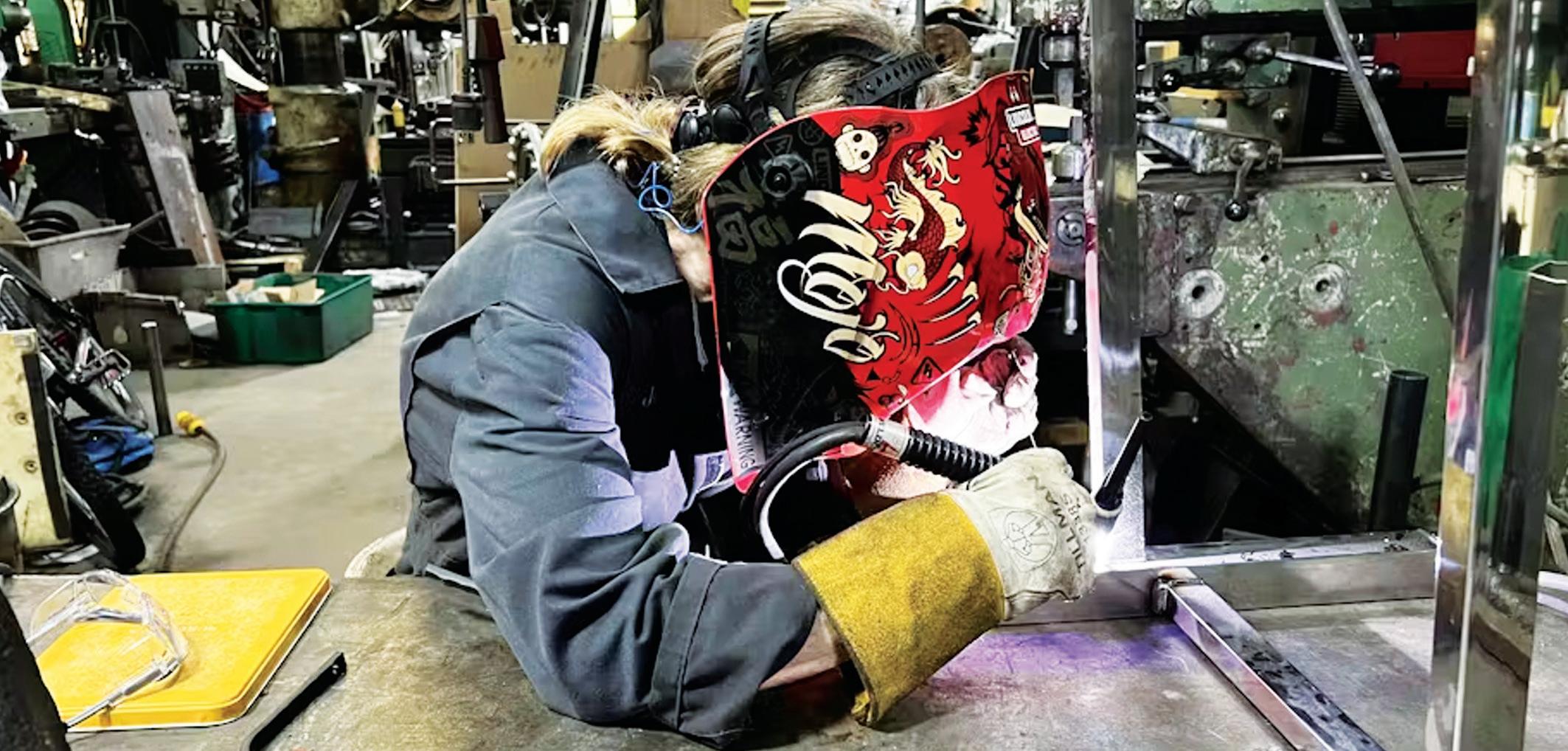
women and found that types of social and cultural capital, such as growing up in a family of tradespeople and being physically strong, led them to be more successful.
Meraiah Foley, a researcher who studies workplace gender equity, and her co-researchers focused on how tradeswomen experience gender harassment – harassment not sexual in nature but focused on gender characteristics. Studying women in aviation and automotive repair in 2019, they found women experience “jokes, jibes, and belittling comments” and bosses who allow such behavior. These behaviors reinforce the view that women are outsiders, making it harder for them to succeed.
Steps forward: Respect, research and cultural shifts
So, has anything improved for women in trades since 1985? While the research clearly shows that problems such as stereotyping, disrespect, scrutiny and harassment haven’t gone away, it would be wrong to say that nothing’s changed. In Chapter 10 of my 2025 book “Learning Skilled Trades in the Workplace,” I discuss some of the challenges that I’ve encountered as a woman in a welding shop. But I also highlight the ways that my
boss and my co-workers have respected my ideas and input, have encouraged me when I’ve made mistakes, have praised my successes, and have generously shared their knowledge. It’s possible to see change in apprenticeship programs aimed at girls and women, scholarships for women studying trades, professional organizations to support tradeswomen, and, perhaps most important, growing numbers of women in apprenticeships and skilled-trades work. While the problems that tradeswomen encounter in 2025 haven’t changed in nature since 1985, it seems these problems are more readily acknowledged and less ubiquitous.
Also, the body of research on tradeswomen is growing, which can lead to new solutions to old problems. In 2021, for example, Bridges and her co-researchers looked to scholarship on resilience to understand how male-dominated industries might better support tradeswomen. They found that mentoring, role models and networking opportunities, as well as formal health and safety rules and policies such as flexible schedules, help tradeswomen thrive.
Similarly, while most research on women in skilled trades has historically focused
on tradeswomen in the U.S., Australia, New Zealand and other Western countries, new scholarship is providing insight into the experiences of tradeswomen elsewhere.
For example, education researchers Joyceline Alla-Mensah and Simon McGrath published an article in March 2025 about barriers to Ghanaian women’s participation in skilled trades. Their interviews brought to light new findings – for example, the importance of land ownership to Ghanaian tradeswomen. Researchers are just now beginning to understand the experiences of women in trades all around the world.
Back in 1985, Schroedel wrote that she had three goals for “Alone in a Crowd”: to let women doing nontraditional work know that they’re not alone, to shed light on their work situations, and to tell the largely overlooked stories of working-class women. While the outlook for tradeswomen is brighter than it was back in 1985, it would nevertheless be possible to begin a 2025 sequel to “Alone in a Crowd” with the same three goals. And that says something about how far the U.S. has yet to go.
Disclosure statement I work for Howe's Welding and Metal Fabrication.
What happens when AI comes to the cotton fields
Precision agriculture uses tools and technologies such as GPS and sensors to monitor, measure and respond to changes within a farm field in real time. This includes using artificial intelligence technologies for tasks such as helping farmers apply pesticides only where and when they are needed. However, precision agriculture has not been widely implemented in many rural areas of the United States. We study smart communities, environmental health sciences and health policy and community health, and we par-
ticipated in a research project on AI and pesticide use in a rural Georgia agricultural community.
Our team, led by Georgia Southern University and the City of Millen, with support from University of Georgia Cooperative Extension, local high schools and agriculture technology company FarmSense, is piloting AI-powered sensors to help cotton farmers optimize pesticide use. Georgia is one of the top cotton-producing states in the U.S., with cotton contributing nearly US$1 billion to the state’s economy in
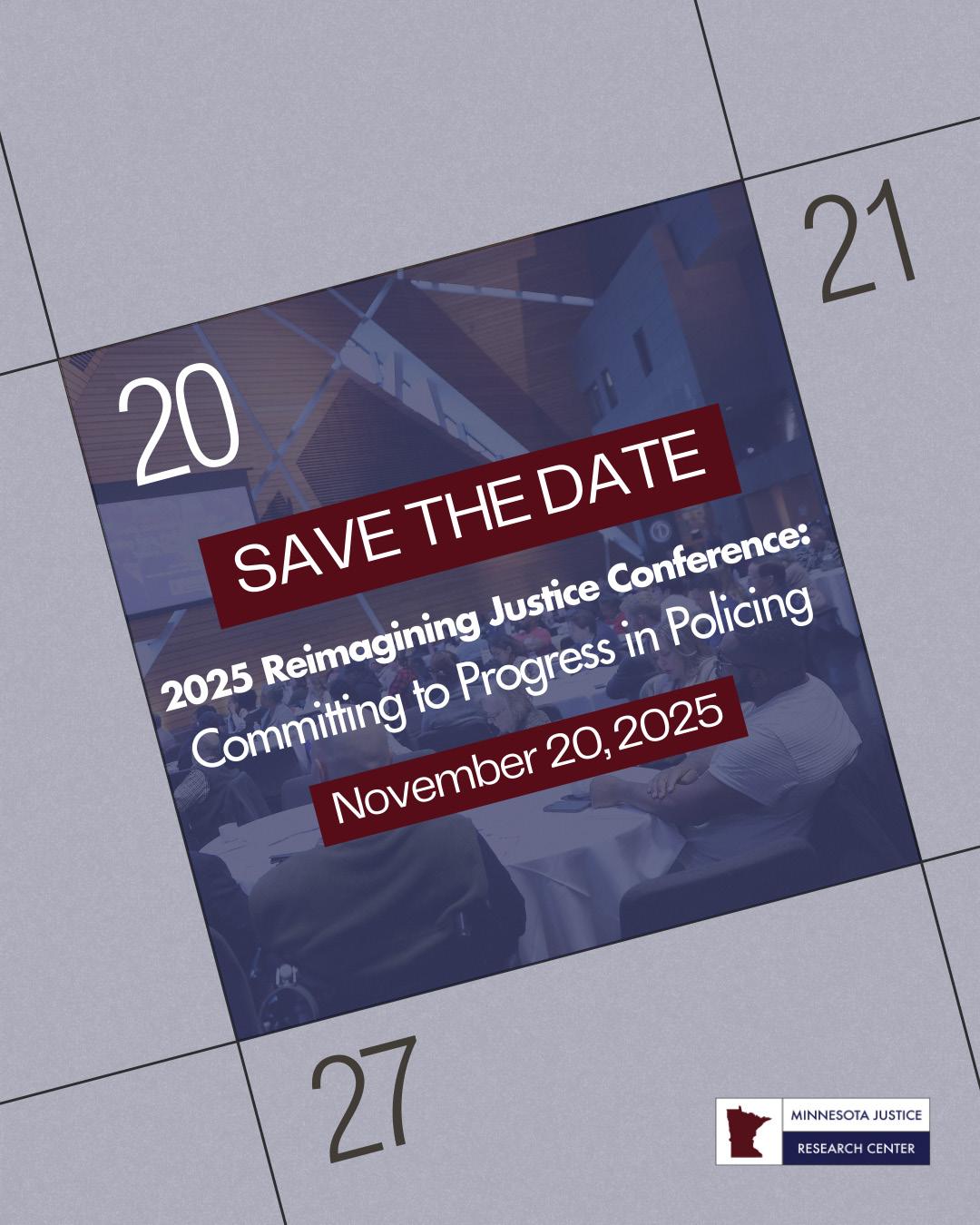


Credit:H. Lux
The author, Jo Mackiewicz, tig-welds a chair at Howe’s Welding and Metal Fabrication in Ames, Iowa. She works with two other women at the shop
Credit:Jo Mackiewicz
Credit: Dorothy Seybold A researcher works in a cotton field in Jenkins County, Georgia, as part of a project on AI and pesticide use.
After plunge, Black students enroll in Harvard
By Stacy M. Brown Black Press USA Senior National Correspondent
Black student enrollment at Harvard Law School has rebounded. The incoming J.D. Class of 2028 includes 46 Black students, nearly returning to the averages seen between 2020 and 2023. That recovery comes only one year after the number collapsed to 19, the lowest since the 1960s. The collapse of 2024 was severe. Harvard law professor David B. Wilkins told The New York Times, “This is the lowest number of Black entering first-year students since 1965.” He added, “This obviously has a lot to do with the
chilling effect created by that decision.” In a statement, Sean Wynn, president of the Harvard Black Law Students Association, said the enrollment decline was a “crushing loss” and that “with this marked decline, the (Supreme Court’s Affirmative Action) ruling has broken something fundamental about the experience of attending this law school.” The chilling effect extended across higher education. Harvard College’s freshman class saw the share of Black students drop from 18 percent in 2023 to 14 percent in 2024. At the University of North Carolina, Black enrollment fell from 10.5 percent to 7.8 percent. The Massachusetts Institute of Technology reported a drop from 16 percent to 6 per-

cent. Princeton’s Class of 2029 enrolled only 5 percent Black students, the lowest since 1968. The source of these declines was the Supreme
Court’s decision in 2023 to end race-conscious admissions. In his majority opinion, Chief Justice John Roberts wrote, “Eliminating racial discrimination
means eliminating all of it.”
The ruling overturned decades of precedent, closing a door that had offered Black students a measure of access to the na-
tion’s most selective institutions. Harvard’s rebound this fall was driven not by structural change but by extraordinary efforts within its community. Black alumni and the Harvard Black Law Students Association launched new outreach and recruitment programs, according to The Harvard Crimson. Still, the rebound came even as Harvard shuttered diversity offices and ended a minority recruitment initiative for undergraduates. The numbers at Harvard show a fragile recovery. They are part of a larger struggle that continues in classrooms and courthouses across the country, where the future of access and opportunity for Black students is contested each year.
Birding by ear: How to learn the songs of nature’s symphony with some simple techniques
kettle”.
By Chris Lituma Assistant Professor of Wildlife
Waking up to the dawn chorus of birds – one of the natural world’s greatest symphonies –is a joy like no other. It is not surprising that bird-watching has become an increasingly popular hobby.
A simple way to start bird-watching is to buy a feeder, a pair of binoculars and a field guide, and begin watching birds from your window.
However, one of the most rewarding ways to identify birds is to listen to them and learn to recognize their songs.
As an ornithologist and educator, I often introduce students to the intricacies of bird songs, and I have developed some tricks that can make birding by ear less daunting.
Learning to listen
Learning bird songs is the difference between “hearing” and “listening.”
Listening requires full attention and limiting distractions. It means using your ears to pick up different patterns in the sounds that birds make. Every person has the capacity to listen and learn patterns in
sound.
If I were to sing “da-da-da-DUM” most people would immediately recognize it as Beethoven’s Symphony No. 5. Alternatively, if I were to play the first few notes or beats of your favorite song, I’m certain you would know what it was and who sang it.
and Fisheries Resources, West Virginia University Goodbye,
The ability to recognize bird songs uses the same part of the brain you use to recognize songs on the radio – the supratemporal, or auditory, cortex, an area just above the ears where your brain processes language and sound.
When you’re birding by ear, you use the same skills as when you’re recognizing music; listening to sounds, patterns, changes in pitch, in tone and in volume, but in nature rather than in music.
You can do this.
To begin learning to recognize bird songs, select two to three common bird songs that you hear frequently around your neighborhood.
Sometimes there are mnemonics that you can use to help remember the songs. For instance, the tufted titmouse says “peter, peter, peter” over and over. Sometimes it sings it fast, sometimes slow, but always “peter, peter, peter.”
Whereas the Carolina wren says, “tea kettle, tea kettle, tea
Songbirds aren’t the only birds with helpful mnemonics. Next time you hear a hooting sound, if it sounds like “who cooks for you, who cooks for you all,” that’s a barred owl.
Why and how songbirds sing
Watching the actual bird sing its song is one of the best ways to learn the bird and song together. Find a tufted titmouse and watch it sing “peter, peter, peter,” and you will remember it forever.
Try going out into the woods with your binoculars and following unfamiliar sounds.
Many species make unique sounds as they sing, chirp, hoot, screech or whistle. They vocalize like this for a variety of reasons – to attract a mate, defend a territory, alert other birds to threats, or to locate other individuals to form flocks or groups.
Songbirds, such as the tufted titmouse and northern cardinal, are the group that ornithologists associate most with complex songs. They tend to have multiple notes and patterns that change in pitch and speed, rather than simple one-note or two-note calls.
These birds have a unique voice box called the syrinx, which translates to “double flute” in Greek and allows them

to create two sounds at once. Birds learn their songs in multiple ways. Songbirds are born with an innate “template,” which tells them the basics for the song to sing. But they also learn from listening to adults.
Studies have found regional dialects of birds’ songs and evidence that some birds learn songs from their parents while still in the shell. Sometimes they learn songs from neighbors, who usually end up becoming competitors for territory.
Human activities can affect birdsong
Human behaviors can also affect how birds sing. Studies have found that, in some instances, background noise can weaken territorial responses in males. And light pollution in suburban areas can prolong singing by up to an
hour.
In 1962, scientist and conservationist Rachel Carson wrote the book “Silent Spring” after noticing how quiet the spring had become when the bird migration would normally be underway. The pesticide DDT had weakened egg shells, triggering a sharp decline in many bird populations. Many scholars and historians identify this book as leading to the creation of the U.S. Environmental Protection Agency under President Richard M. Nixon in 1970.
Getting started birding by ear
As you start learning bird songs, technology can come in handy. There are now dedicated apps, such as Cornell University’s Merlin, that can help you recognize bird songs as you are listening to them.
However, human
abilities still outperform this technology, so use apps as a learning tool, not a crutch. As humans, we have long depended on our ability to communicate with each other. I think we relate to birds because they are such vocal creatures too.
Learning their songs is a lifelong endeavor. Once you start tuning into the natural world, you’ll realize that there is something new waiting to be discovered.
Disclosure statement
Chris Lituma does not work for, consult, own shares in or receive funding from any company or organisation that would benefit from this article, and has disclosed no relevant affiliations beyond their academic appointment.
for Innovation program provides seed funding and technical support for community research teams. This support enables local problem-solving that strengthens both research scholarship and community outcomes. The program has recently focused on the role of civic artificial intelligence – AI that supports communities and local governments. Our project on cotton field pesticide use is part of this program. Cotton pests and pesticides
on the 2022 agricultural county profiles census, Jenkins County ranked 173rd out of the 765 counties producing cotton in the United States.
Our project in Jenkins County, Georgia, is testing that potential. Jenkins County, with a population of around 8,700, is among the top 25 cotton-growing counties in the state. In 2024, approximately 1.1 million acres of land in Georgia were planted with cotton, and based
We’re Building a Better Home-Buying Experience. From hammers and walls to stronger futures, we’ve always been about housing. Now, we’re making homeownership easier than ever.
Start your journey with us Visit www.tchabitat.org.
The state benefits from fertile soils, a subtropical-to-temperate climate, and abundant natural resources, all of which support a thriving agricultural industry. But these same conditions also foster pests and diseases. Farmers in Jenkins County, like many farmers, face

numerous insect infestations, including stink bugs, cotton bollworms, corn earworms, tarnished plant bugs and aphids. Farmers make heavy use of pesticides. Without precise data on the bugs, farmers end up using more pesticides than they likely need, risking residents’ health and adding costs. While there are some existing tools for integrated pest management, such as the Georgia Cotton Insect Advisor app, they are not widely adopted and are limited to certain bugs. Other methods, such as traditional manual scouting and using sticky traps, are labor-intensive and time-consuming, particularly in the hot summer climate.
Our research team set out to combine AI-based early pest detection methods with existing integrated pest management practices and the insect advisor app. The goal was to significantly improve pest detection, decrease pesticide exposure levels and reduce insecticide use on cotton farms in Jenkins County. The work compares different insect monitoring methods and assesses pesticide levels in both the fields and nearby semi-urban areas.
We selected eight large cotton fields operated by local farmers in Millen, four active and four control sites, to collect environmental samples before farmers began planting cotton and applying pesticides.
The team was aided by a new AI-based insect monitoring system called the FlightSensor by FarmSense. The system uses a machine learning algorithm that was trained to recognize the unique wingbeats of each pest insect species. The
specialized trap is equipped with infrared optical sensors that project an invisible infrared light beam – called a light curtain – across the entrance of a triangular tunnel. A sensor monitors the light curtain and uses the machine learning algorithm to identify each pest species as insects fly into the trap.
FlightSensor provides information on the prevalence of targeted insects, giving farmers an alternative to traditional manual insect scouting. The information enables the farmers to adjust their pesticide-spraying frequency to match the need.
What we’ve learned
Here are three things we have learned so far:
1. Predictive pest control potential – AI tools can help farmers pinpoint exactly where pest outbreaks are likely – before they happen. That means they can treat only the areas that need it, saving time, labor and pesticide costs. It’s a shift from blanket spraying to precision farming – and it’s a skill farmers can use season after season.
2. Stronger decision-making for farmers – The preliminary results indicate that the proposed sensors can effectively monitor insect populations specific to cotton farms. Even after the sensors are gone, farmers who used them get better at spotting pests. That’s because the AI dashboards and mobile apps help them see how pest populations grow over time and respond to different field conditions. Researchers also have the ability to access this data remotely through satellite-based monitoring platforms on their computers, further enhancing the collaboration and learning.
3. Building local agtech talent – Training students and farmers on AI pest detection is doing more than protecting cotton crops. It’s building digital literacy, opening doors to agtech careers and preparing communities for future innovation. The same tools could help local governments manage mosquitoes and ticks and open up more agtech innovations. Blueprint for rural innovation
By using AI to detect pests early and reduce pesticide use, the project aims to lower harmful residues in local soil and air while supporting more sustainable farming. This pilot project could be a blueprint for how rural communities use AI generally to boost agriculture, reduce public health risks and build local expertise. Just as important, this work encourages more civic AI applications – grounded in real community needs – that others can adopt and adapt elsewhere. AI and innovation do not need to be urban or corporate to have a significant effect, nor do you need advanced technology degrees to be innovative. With the right partnerships, small towns, too, can harness innovations for economic and community growth.
Disclosure statement
The authors do not work for, consult, own shares in or receive funding from any company or organisation that would benefit from this article, and have disclosed no relevant affiliations beyond their academic appointment.
Insight 2 Health
Democrats dig in: healthcare at the center of looming shutdown fight
By Stacy M. Brown Black Press USA Senior National Correspondent
The air in Washington has grown thick with a familiar tension, the kind that precedes the shuttering of government offices and the silencing of paychecks for thousands of workers. Yet at the heart of this looming shutdown lies something far greater than partisan brinkmanship: a ferocious fight for the soul of America’s healthcare. Democrats have planted themselves firmly in the path of what they call a reckless assault on Medicaid and the Affordable Care Act. They are not speaking in the language of compromise this time. They are speaking in the cadence of survival—for the poor, the sick, the disabled, and the working families who stand to see their coverage ripped away.
Senate Democratic

leader Chuck Schumer warned of what was at stake. “Senators will have to choose: to stand with Donald Trump and keep the same lousy status quo and cause the Trump healthcare shutdown, or stand with the American people, protect their healthcare, and keep the government functioning,” he said.
House Democratic leader Hakeem Jeffries framed the fight with defiance. “We don’t work for Donald Trump, we don’t work for JD Vance, we don’t work for Elon Musk, we work for the American people. And that is why we are a hard no on the partisan Republican spending bill because it continues to
gut the healthcare of everyday Americans,” he stated. In their joint letter to President Trump, Schumer and Jeffries accused him of deliberately courting a shutdown to “gut the healthcare of the American people.” They wrote, “We do not understand why you prefer to shut down the government
rather than protect the healthcare and quality of life of the American people,” they stated.
Journalist Karen Tumulty analyzed the Democrats’ approach, noting that the minority party, though constrained in power, is wielding rare leverage in this moment. They have tied their stand to demands that strike at the heart of Trump’s agenda: restoring Medicaid funds slashed earlier this year, extending Affordable Care Act subsidies that are set to expire, and halting the administration’s freeze on appropriated dollars. Sen. Chris Van Hollen of Maryland cut to the essence of Democratic resistance. “I’m not going to write a blank check for a lawless president. That is my starting point here,” he said. The stakes, Democrats argue, are not abstract. They warn that millions could see premiums soar, hospitals and clinics could close, and the poorest communities—urban and rural alike—could be left without care. In Delaware,
Sen. Chris Coons described how both the most urban and most rural hospitals in his state depend heavily on Medicaid.
“Part of our challenge is lots of people haven’t felt that yet, but they will next month,” he said. The president has brushed aside these warnings, saying there may be “a closed country for a period of time,” even as he pledged to shield the military and Social Security checks, he stated. Illinois Gov. JB Pritzker made clear where he stands. “I’m on Team Fight. You don’t think Republicans would use every ounce of leverage they would have in this circumstance?” he said. For Democrats, the fight is not just about numbers on a spreadsheet, but about what kind of nation America chooses to be. They are wagering that voters, when confronted with rising costs and shuttered care, will see the struggle not as political theater but as a line drawn in defense of their health and their dignity.
Vaccine mandates misinformation: 2 experts explain the true role of slavery and racism in the history of public health policy – and the growing threat ignorance poses
By Lauren MacIvor Thompson Assistant Professor of History and Interdisciplinary Studies, Kennesaw
State University
What’s clear: Vaccines and mandates save human lives
and 19th-century anti-vaccination societies urged the rollback of state laws requiring vaccination.
Black Americans’ long fight for public health equity
Stacie Kershner Deputy
Director of
the Center for Law, Health & Society, Georgia State University
On Sept. 3, 2025, Florida announced its plans to be the first state to eliminate vaccine mandates for its citizens, including those for children to attend school.
Current Florida law and the state’s Department of Health require that children who attend day care or public school be immunized for polio, diphtheria, rubeola, rubella, pertussis and other communicable diseases. Dr. Joseph Ladapo, Florida’s surgeon general and a professor of medicine at the University of Florida, has stated that “every last one” of these decades-old vaccine requirements “is wrong and drips with disdain and slavery.”
As experts on the history of American medicine and vaccine law and policy, we took immediate note of Ladapo’s use of the word “slavery.”
There is certainly a complicated history of race and vaccines in the United States. But, in our view, invoking slavery as a way to justify the elimination of vaccines and vaccine mandates will accelerate mistrust and present a major threat to public health, especially given existing racial health disparities. It also erases Black Americans’ key work in centuries of American public health initiatives, including vaccination campaigns.
By Stacy M. Brown
Black Press USA Senior National Correspondent
For more than five years, Dr. Olumuyiwa Bamgbade carried the weight of lies that he should never have borne. He is a Black doctor, a healer by training, acquitted of false accusations that Canadian authorities and media were eager to trumpet but too arrogant, too complicit, to retract. The silence after his vindication was louder than the slander that preceded it. The cruelty is not simply in the malicious lies about him, but in the determination of a system to criminalize his very existence. However, he continues to meet injustice with compassion. Dr. Bamgbade never abandoned his calling. While others would have broken under the torment of malicious persecutions, he
Evidence and data show that vaccines work, as do mandates, in keeping Americans healthy. The World Health Organization reported in a landmark 2024 study that vaccines have saved more than 154 million lives globally in just the past 50 years.
In the United States, vaccines for children are one of the top public health achievements of the 20th century. Rates of eight of the most common vaccine-preventable diseases in school-age children dropped by 97% or more from pre-vaccine levels, preventing an estimated 1,129,000 deaths and resulting in direct savings of US$540 billion and societal savings of $2.7 trillion.
History of vaccine mandates in the United States
Vaccine mandates in the United States date to the Colonial period and have a complex history. George Washington required his troops be inoculated, the predecessor of vaccination, against smallpox during the American Revolution.
To prevent outbreaks of this debilitating, disfiguring and deadly disease, state and local governments implemented smallpox inoculation and vaccination campaigns into the early 1900s. They targeted various groups, including enslaved people, immigrants, people living in tenement and other crowded housing conditions, manual laborers and others, forcibly vaccinating those who could not provide proof of prior vaccination.
Although religious exemptions were not recognized by law until the 1960s, some resisted these vaccination campaigns from the beginning,
remains at his Surrey, BC, medical clinic, treating those the system itself has left behind: people with pain, trauma, substance misuse, insomnia, and neuropathies. Unlike other pain clinics, he does not demand outof-pocket costs. He tends to the people society neglects, many without primary healthcare.
He recalls how, in 2020, a woman, furious that his teenage staff rejected her sexual advances, turned her bitterness into a weapon. She was also sexually abusing two vulnerable teenagers in her neighborhood. Dr. Bamgbade condemned these illegal activities. She falsely accused him of assault, though eyewitnesses and forensic evidence destroyed her story. Toxicology reports revealed her abuse of opioids and psychedelics: substances she was jailed for trafficking before, substances she continues selling. She sought money
By the turn of the 20th century, however, the U.S. Supreme Court also began to intervene in matters of public health and vaccination. The court ultimately upheld vaccine mandates in Jacobson v. Massachusetts in 1905, in an effort to strike a balance between individual rights with the need to protect the public’s health. In Zucht v. King in 1922, the court also ruled in favor of vaccine mandates, this time for school attendance.
Vaccine mandates expanded by the middle of the 20th century to include vaccines for many dangerous childhood diseases, such as polio, measles, rubella and pertussis. When Jonas Salk’s polio vaccine became available, families waited in long lines for hours to receive it, hoping to prevent their children from having to experience paralysis or life in an iron lung.
Scientific studies in the 1970s demonstrated that state declines in measles cases were correlated with enforcement of school vaccine mandates. The federal Childhood Immunization Initiative launched in the late 1970s helped educate the public on the importance of vaccines and encouraged enforcement. All states had mandatory vaccine requirements for public school entry by 1980, and data over the past several decades continues to demonstrate the importance of these laws for public health.
Most parents also continue to support school mandates. A survey conducted in July and August 2025 by The Washington Post and the Kaiser Family Foundation finds that 81% of parents support laws requiring vaccines for school.
from him: he rejected her extortion. In her malice, Canadian authorities saw an opportunity. They did not see the criminality of a woman preying on children and trading narcotics. They saw only a Black man to scapegoat. In 2022, another woman tried to capitalize on the publicized scapegoating. She appeared in his clinic, weeping, prompting him to show her to a room. She requested medications. He kindly gave her the same dose of her regular daily anxiolytic. When he would not indulge her further, she accused him of touching her fully-clothed body in a clinic filled with staff and patients. She deleted electronic communications to and from the clinic. Yet, six police cars stormed Dr. Bamgbade’s celebration in a show of force that had less to do with justice and more to do with terror. Evidence was manipulated, witnesses intimidated, but in court, truth
Despite the proven success of vaccines and the importance of vaccine mandates in maintaining high vaccination rates, there is a vocal anti-vaccine minority in the U.S. that has gained traction since the COVID-19 pandemic. Misinformation proliferates both online and off. Some of the misinformation originates in the historical realities of vaccines and social policy in the United States. When Ladapo, the Florida surgeon general, invoked the term “slavery” to refer to vaccine mandates, he may have been referring to the history of racism in the medical field, such as the U.S. Public Health Service Untreated Syphilis Study at Tuskegee. The study, which started in 1932 and spanned four decades, involved hundreds of Black men who were recruited without their knowledge or consent so that researchers could study the effects of untreated syphilis. Investigators misled the participants about the nature of the study and actively withheld treatment – including penicillin, which became the standard therapy in the late 1940s – in order to study the effects of untreated syphilis on the men’s bodies.
Today, the study is remembered as one of the most egregious instances of racism and unethical experimentation in American medicine. Its participants had enrolled in the study because it was advertised as a chance to receive expert medical care but, instead, were subjected to lies and painful “treatments.”
Despite these experiences in the medical system, Black Americans have long advocated for better health care,
endured. The judge declared her testimony “riddled with material inconsistencies and improbabilities.”
The authorities perpetuated a media campaign against him. As a result, another woman, discharged from his clinic in 2019, sought to build her own profit from his public humiliation. She claimed he touched her fully-clothed body. Years later, her accusations collapsed under cross-examination, her criminal schemes unraveling in open court. She fled the witness stand, unwilling to continue. She commits extortion, identity fraud, and makes her second ex-husband pay child support for a child that he did not father. Prosecutors offered Dr. Bamgbade plea bargains. He refused them. “I insisted on clearing my name in court,” he declared. His questions remain unanswered: where is the rule of law, accountability, and eq-
connecting it to the larger struggle for racial equality. Vaccination is no exception. Despite the fact that they were often the subject of forced innoculation, enslaved people helped to lead the first American public health initiatives around epidemic disease. Historians’ research on smallpox and slavery, for example, has found that inoculation was widely accepted and practiced by West Africans by the early 1700s, and that enslaved people brought the practice to the Colonies.
Although his role is often downplayed, an African man known as Onesimus introduced his enslaver Cotton Mather to inoculation.
Throughout the next century, enslaved people often continued to inoculate each other to prevent smallpox outbreaks, and enslaved and free people of African descent played critical roles in keeping their own communities as healthy as possible in the face of violence, racism and brutality. The modern Civil Rights Movement explicitly drew on this history and centered health equity for Black Americans as one of its key tenets, including working to provide access to vaccines for preventable diseases.
In our view, Ladapo’s reference to vaccines as “slavery” ignores this important and nuanced history, especially Black Americans’ role in the history of preventing communicable disease with vaccines.
Lessons to learn from Tuskegee
Ladapo’s word choice also runs the risk of perpetuating the rightful mistrust that continues to exist in communities of color about vaccines and the American health system more broadly. Studies show that lin-

uity? Why did the authorities pursue ghosts of offenses that never happened, while ignoring the crimes of his accusers? Why did they labor to criminalize a Black physician, while the women who lied are driving sports cars and SUVs funded by fraud?
Dr. Bamgbade is more than a survivor of injustice. He is a physician of global
gering effects of Tuskegee and other instances of medical racism have had real consequences for the health and vaccination rates of Black Americans.
A large body of evidence shows the existence of persistent health disparities for Black people in the United States compared with their white counterparts, leading to shorter lifespans, higher rates of maternal and infant mortality and higher rates of communicable and chronic diseases, with worse outcomes.
Eliminating vaccine mandates in Florida and expanding exemptions in other states will continue to widen these already existing disparities that stem from past public health wrongs.
There is an opportunity here, however, for health officials, not just in Florida but across the nation, to work together to learn from the past in making American public health better for everyone. Rather than weakening vaccine mandates, national, state and local public health guidance can focus on expanding access and communicating trustworthy information about vaccines for all Americans. Policymakers can acknowledge the complicated history of vaccines, public health and race, while also recognizing how advancements in science and medicine have given us the opportunity to eradicate many of these diseases in the United States today.
Disclosure statement
The authors do not work for, consult, own shares in or receive funding from any company or organisation that would benefit from this article, and have disclosed no relevant affiliations beyond their academic appointment.
stature, trained across Nigeria, Britain, the United States, and South Korea. He is an adjunct professor, the author of 60 peer-reviewed publications, and a research collaborator across more than 20 nations. He leads Salem Anaesthesia Pain Clinic in Canada, where care is more than procedure: it is a commitment to equity, the rehabilitation of the injured, and the forgotten and neglected. Yet,
Picture courtesy of Dr. Bamgbade
Kaelen Culpepper and Connor Prielipp named 2025 Twins minor league player and pitcher of the year
MINNEAPOLIS/ST. PAUL, MN — The Minnesota Twins announced today that infielder Kaelen Culpepper has been named the 2025 Sherry Robertson Award winner as the Twins minor league Player of the Year and left-handed pitcher Connor Prielipp has been named the 2025 Jim Rantz Award winner as the Twins minor league Pitcher of the Year.
Culpepper, 22, split the 2025 minor league season between High-A Cedar Rapids and Double-A Wichita, hitting a combined .289 (131-for-454) with 16 doubles, three triples, 20 home runs, 64 RBI, 50 walks, 25 stolen bases, 77 runs scored and an .844 OPS in 113 games during his second professional campaign. The 6-foot, 185-pound infielder was second among all Twins farmhands in
hits and tied for third in runs scored, while ranking fourth in total bases (213), fifth in doubles and eighth in RBI. He was a two-time Twins minor league Player of the Week (May 25 with Cedar Rapids and August 10 with Wichita) and represented the Twins at the 2025 SiriusXM All-Star Futures Game at Truist Park in Atlanta, going 0-for-1 as a reserve at second base. Culpepper also recorded multiple hits in 33 of his 113 games played, including four different four-hit performances. He began his season with the Kernels and hit .293 (63-for215) with nine doubles, two triples, nine home runs, 34 RBI, 26 walks, 15 stolen bases, 38 runs scored and an .864 OPS in 54 games, despite missing time on the 7-day Injured List from April 12-22 with a right wrist
sprain. Culpepper was promoted to Wichita on June 20 and hit .285 (68-for-239) with seven doubles, one triple, 11 home runs, 30 RBI, 24 walks, 10 stolen bases, 39 runs scored and an .827 OPS in 59 games for the Wind Surge.
The Memphis, Tennessee native was selected by the Twins in the first round (21st overall) of the 2024 FirstYear Player Draft out of Kansas State University. He is currently ranked as the No. 4 prospect in the Twins organization and the No. 72 overall prospect in baseball, per MLB.com.
Prielipp, 24, went 1-9 with a 4.03 ERA (82.2 IP, 37 ER), 31 walks, 98 strikeouts and a 1.51 WHIP in 24 games (23 starts) between Wichita and Triple-A St. Paul in the 2025 minor league season, his first
full professional campaign. The 6-foot-2, 210-pound southpaw ranked second among all Twins pitchers in starts and was tied for seventh in strikeouts, despite missing time on the 7-day Injured List from June 9-21 with a blister. He began the season with the Wind Surge, where he was named Twins minor league Pitcher of the Week on May 11 after tossing 4.0 scoreless innings with just three hits allowed, no walks and six strikeouts on May 8 at Northwest Arkansas. After posting a 3.65 ERA (61.2 IP, 25 ER) with 18 walks, 73 strikeouts, a 1.49 WHIP and an 0-6 record in 19 starts for Wichita, Prielipp was promoted to St. Paul on August 16, where he finished out the season with five appearances (4 starts) for the Saints, going 1-3 with a 5.14 ERA (21.0 IP,
12 ER), 13 walks, 25 strikeouts and a 1.57 WHIP. Those outings included a start on September 13 vs. Columbus in which he matched his career high with six strikeouts across 5.0 innings of work.
The Tomah, Wisconsin native was selected by the Twins in the second round (48th overall) of the 2022 First-Year Player Draft out of the University of Alabama. He is currently ranked as the No. 10 prospect in the Twins organization and fourth-best pitcher, per MLB. com. The Sherry Robertson Award, named in honor of the Twins’ first farm director, was established in 1970 to recognize the top Twins minor league performer (player or pitcher) each season; since 2002, the award has strictly recognized the
Trump’s attacks on federal workers are attacks on Black workers, the labor movement is fighting back
By Fred Redmond
During the 2024 presidential campaign, now-Director of the Office of Management and Budget Russell Vought said he wanted to put federal workers “in trauma.” Project 2025 called union representation of government workers “incompatible with democracy” and recommended Congress make having a voice on a federal job illegal.
Now, as president, Trump has taken drastic steps to turn the Project 2025 agenda into a frightening reality. In addition to appointing Vought, he gave the world’s wealthiest person, Elon Musk, unfettered access to federal data and systems
while his team of inexperienced groupies slashed core government functions and the workers who supported them—the more cruel and random the better.
Nine months into Trump’s second term, 1 in 8 federal workers have been pushed out of their jobs—about 300,000 in total, the largest single-year reduction since World War II. In March, the Trump administration stripped nearly a million federal workers of their right to collectively bargain in the single biggest act of union-busting in history. And then, right before Labor Day, added more workers to that list. Nearly 450,000 workers at the departments of Agriculture, Health and Human Services, Homeland Security, and Veter-
ans Affairs, as well as the Environmental Protection Agency, have had their union contracts canceled altogether. Attacks on federal workers aren’t just a problem for their families or their unions—they hurt all of us and jeopardize the essential government services we rely on daily. These workers make sure our food and water are safe and our communities are free from pollution. They protect our families during public health emergencies, care for our veterans, and monitor extreme weather and natural disasters. When workers can’t speak up on the job and make sure their offices are serving the American people, we are all at risk.
For Black Americans,

Trump’s attacks on the federal workforce threaten to reverse decades of progress. In 1948, well before the passage of the Civil Rights Act, President Truman signed executive orders to abolish segregation in the military and prohibit race-based
discrimination in the federal government. Government jobs became one of the few places Black Americans could put their education and skills to use and reliably get good benefits and pay in return, and for many, they opened the door to the middle



Sharing Our Stories
Books, Art & Culture

By W.D. Foster-Graham Book Review Editor
Athletics and sports are areas of expertise we as people of African descent are known for. In football, baseball, and basketball, we hear names like Jackie Robinson, Hank Aaron, Willie Mays, Wilt Chamberlain, Kareem Abdul-Jabbar, Michael Jordan, Jason Collins, Jim Brown, Walter Payton, Ahmad Rashad, Alan Page, Michael Strahan, and so on.
Today, in the WNBA, we have notable players such as Sheryl Swoopes and Brittney Griner. But let’s take a look
Lusia Harris, basketball star
at the shoulders these women stand upon in Nancy Loewen’s children’s book Lusia Harris: Basketball Star.
Born in 1955 in Minter City, Mississippi, Lusia (Lucy) Harris was one of 11 children born to her cotton farmer parents. She studied the moves of NBA greats such as Wilt Chamberlain and Oscar Robertson. Standing at 6’3” when she entered high school, Harris was a star basketball player, becoming team captain and MVP.
When it was time for college, she attended Delta State University. In 1973, she was one of the few Black students there and the only Black woman on the basketball team. While getting the grades in her classes, Harris led the team to
three national championships, was named MVP for all three, and voted Delta State’s homecoming queen. Though she was a force to be reckoned with on the court, she was humble off it.
To add to her accomplishments, Harris became an Olympic medalist at the 1976 Olympics and the first woman to be drafted by the NBA; she turned the offer down to start a family with her husband George Stewart. They were blessed with four children.
Her career after basketball took her back to Delta State, where she became an admissions counselor and basketball coach, obtaining her master’s degree in special education. Ironically, Harris never quite realized the impact she made and the doors she opened
in women’s sports until years later, earning her place in the Women’s National Basketball Hall of Fame. Though her life was cut short in 2022, her legacy had a long reach. It is indeed inspiring what this Hall of Famer had accomplished in her life and in the lives of her family and other women that followed her in succeeding generations. In her words, “If you can dream it, you can do it.”
Lusia Harris: Basketball Star is available through Amazon, Bookshop.com, and the Planting People Growing Justice website (www.ppgjli. org).
Thank you, Nancy, for another chapter in the ongoing saga of trailblazers making a difference!

Even as Jimmy Kimmel returns to the airwaves, TV networks remain more vulnerable to political pressure than ever before
By Sage Meredith Goodwin
Postdoctoral Fellow at the Center for American Political History and Technology, Purdue University
Oscar Winberg
Postdoctoral Fellow, Turku Institute for Advanced Studies & John Morton Center for North American Studies, University of Turk
“Is there any way we can screw him?” asked President Richard M. Nixon.
“We’ve been trying to,” an aide replied, alluding to the White House’s efforts to remove from the airwaves an ABC talk show host whose critiques of the administration had placed that “son of a b—h” on the chief executive’s enemies list.
Over 50 years ago, Nixon and his team sought to use the full weight of the federal government – with calls to network executives, Federal Communications Commission complaints, IRS audits and FBI investigations – to silence “The Dick Cavett Show.” Cavett, who seemed to personify the liberalism that Nixon despised, had drawn the president’s ire by platforming anti-war activists like John Kerry and Jane Fonda, along with left-wing radicals such as Stokely Carmichael.
Nixon ultimately failed in his attempt to silence Cavett. ABC executives were committed to independent media, while the broadcasting industry as a whole had garnered the attention and trust of an enormous audience, which insulated them from political pressure.
It’s a sharp contrast to President Donald Trump’s second term, during which he has loudly announced his desire to rid the nation’s televisions of his critics, and is making headway in doing so. In July 2025, CBS
announced the cancellation of Stephen Colbert’s late night show. While the network maintained this was “purely a financial decision” based on ratings, it came in the wake of Colbert mocking both the president and the network.
“I hear Kimmel is next,” Trump crowed in the days after. Lo and behold, ABC briefly suspended Jimmy Kimmel on Sept. 17 over comments the comedian made about the response to the murder of rightwing activist Charlie Kirk. The suspension was lifted five days later, after it generated widespread backlash and became a flash point for free speech debates in the U.S.
But why has Trump been able to shake up late-night TV in ways Nixon never could?
It’s tempting to think of the network era – those decades in the 20th century when CBS, NBC and ABC dominated television – as a golden age of independent broadcasting and free expression.
However, as political historians of media, we know from our research that TV has always been a battleground of politics, business interests and broadcasting ideals.
The apparent appeasement of Trump by network executives shows just how much has changed in both the media and regulatory landscape since Nixon’s time.
Television’s decline
Direct pressure from the White House was the immediate catalyst for ABC’s decision to briefly pull the plug on Kimmel.
Brendan Carr, the chair of the FCC, threatened ABC and its affiliates while speaking on the podcast of right-wing commentator Benny Johnson.
“These companies can find ways to change conduct to take action on Kimmel,” he said, “or, you know, there’s going to be additional work for the FCC ahead.” Soon, Nexstar and Sinclair, which own dozens of ABC affiliates, announced that they would pull the show, forcing ABC to act.
That said, network

television’s fading place in the American media ecosystem probably made the call a whole lot easier.
When Nixon was trying to nix “The Dick Cavett Show,” the program averaged 5 million viewers a night. The rival “Tonight Show Starring Johnny Carson” regularly pulled in 11 million viewers.
Yet even Cavett’s relatively smaller audience is more than double what Kimmel and his colleagues in late night television can count on today.
The rise of cable loosened the networks’ chokehold on TV news and entertainment in the late 20th century. The internet – followed by the advent of podcasts, streaming and social media – merely accelerated this trend.
By the 2010s, more viewers were watching clips of late night talk shows on their phones and computers than on television. Today, over 40% of people under 30 say they don’t watch broadcast or cable TV.
Kimmel does have over 20 million subscribers on YouTube and millions more on social media, but ABC has struggled to monetize this following.
In short, late night is no longer the TV crown jewel it once was. As a result, it’s far easier for executives to decide
to cut the cord on a Kimmel or a Colbert.
Deregulation and consolidation Broadcasting has always been a business where those at the top are swayed by the bottom line.
But back in Cavett’s day, top decision-makers at the networks were still dyed-in-thewool broadcasting executives. Leonard Goldenson, the president of ABC whom Nixon’s aides hounded, had created the network from scratch and was invested in the ideals of independent media. Over at CBS, founder William S. Paley had spent decades building the network’s brand and reputation and held similar beliefs. They wanted to shield the respectability of their networks, which made them more resolute when confronted with political attacks. Now, however, the ultimate decisions about what happens at ABC and CBS are made by executives at the megacorporations that own them.
Decades of deregulation – in particular, the Telecommunications Act of 1996, which spurred a wave of media mergers and consolidation – have allowed broadcasting today to be dominated by a handful of
massive conglomerates. They own not only the networks, but also studios, cable channels and internet services.
These media giants need government approval to further expand their empires.
This includes the US$8 billion merger that made Paramount Skydance the owner of CBS in summer 2025 – a deal that was approved just a week after CBS announced the cancellation of “The Late Show with Stephen Colbert.” Disney, which owns ABC, also has major deals pending that require the government’s go-ahead.
If the ultimate goal is ever-increasing profits for shareholders, getting rid of a late night show may seem like a small price to pay – especially if a particular program threatens the government’s sign-off on a massive deal.
Charging ‘liberal bias’
The decline of ratings and media consolidation has left television more vulnerable to attempts at political intimidation than ever before.
Trump is far from the first conservative to use the television networks as a political punching bag. His strategy of tarring national broadcasters with the brush of “liberal me-
dia bias” can be traced back to right-wing media activists who, as early as the 1940s, argued that the mainstream media shut out conservative ideas and voices.
Nixon, convinced that the nation’s television industry was against him, brought those tactics to the White House. In public, he relied on his vice president, Spiro Agnew, to slam the networks as part of an irresponsibly hostile liberal “unelected elite” with “vast power.” In private, Nixon abused the office of the presidency to harass and intimidate broadcasting reporters, directors and executives.
These tactics largely failed. But in Nixon’s wake, partisan media activists like former Fox News executive Roger Ailes and radio host Rush Limbaugh continued to popularize the idea of “liberal media bias” within the conservative movement.
Today, Trump’s charges of “liberal bias” or “fake news” galvanize his supporters – and make media executives sweat – because they’re a key part of modern right-wing identity.
But the president’s no-holds-barred approach is unprecedented. By threatening broadcasting licenses, instigating investigations and filing lawsuits – all while declaring the mainstream media “the enemy of the people” – Trump has turned the dial up to 11. His administration’s success in temporarily getting Kimmel off the air is obviously one more chapter in an ongoing crisis for free speech. Unfortunately, given the trends in the relationship between American media and politics over the past half-century, it likely won’t be the last.
Disclosure statement
The authors do not work for, consult, own shares in or receive funding from any company or organisation that would benefit from this article, and have disclosed no relevant affiliations beyond their academic appointment.
Black workers constitute nearly 20% of the federal workforce. In some agencies—such as the Postal Service and the departments of Education, Housing and Urban Development, the Treasury, and Veterans Affairs—we are 1 in 4 employees. With more than 90% of federal workers living outside the nation’s capital, the effect of Trump’s attacks on the federal workforce spreads nationwide. This is especially
true in the South, where Black workers make up 35% of the federal workforce in a handful of states, including nearly 45% in Georgia alone. Black workers are able to stay and build a stable career in these jobs; 21% of Black federal employees have worked in the government for 20 years or more. And Trump’s attacks are especially harmful for Black women, who themselves are 12% of federal workers, nearly double their share of the workforce overall, and work at some of the agencies hit hardest by the administration’s cuts. By August, the unemployment rate was 6.7% for Black women and 7.1% for
Black men—numbers not seen since the pandemic. Behind these numbers are real people who are bearing the brunt of this administration’s anti-worker, anti-Black agenda. Nonpartisan federal workers, kicked out of the job they relied on for decades, now having to scramble to put food on the table for their families. Dedicated health care workers who have been champions for the care of their patients, now afraid to speak out without their union contract. Cherished colleagues and mentors pushed out of their workplaces by some arbitrary decision about which federal workers’ rights and jobs
matter—and which don’t. The labor movement is no stranger to attacks like these, and we’re not afraid to fight back. Federal workers have been organizing to join and remain part of their unions, even in the face of the Trump administration’s union-busting. They are speaking out and telling their stories, refusing to be silenced about why their jobs and their contracts matter. And we’re fighting to pass the Protect America’s Workforce Act, legislation that would overturn Trump’s union-busting executive orders. The bipartisan bill, introduced by Reps. Jared Golden (D-Maine-02) and
Brian Fitzpatrick (R-Pa.-01), has 221 additional co-sponsors from both parties, and the labor movement and our allies are urging members of Congress to sign a discharge petition to send the bill straight to the House floor for a vote. Last week, Sens. Mark Warner (D-Va.) and Chris Van Hollen (D-Md.), and Minority Leader Chuck Schumer (D-N.Y.) introduced the legislation in the Senate. Black workers didn’t become a major part of the federal workforce by accident. We organized and fought for these jobs and contracts with everything we had. If Trump and his billionaire buddies think they can take away our livelihoods and our unions without a fight, they don’t know the first thing about the labor movement. We’ll continue to push back against this affront to Black Americans—and all workers— with everything we have. Fred Redmond, the highest-ranking African American labor official in history, is the secretary-treasurer of the AFL-CIO, the nation’s largest labor federation, representing 63 unions and nearly 15 million workers.
Lusia Harris, basketball star by Nancy Loewen Book Cover
Credit: Disney Jimmy Kimmel


















